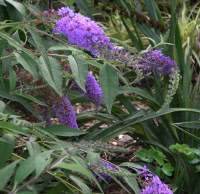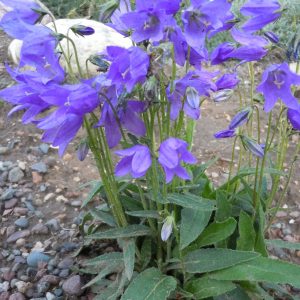Archives
Showing 33–40 of 199 results
-
Butterfly Garden for sun
Butterfly Garden for sun
ARCHIVED
Note: This is a collection not currently for sale. This is an archive page preserved for informational use.
Butterfly Garden for Sun Size : Height x width* Bloom color
3 Agastache foeniculum – Anise hyssop 2-3’ x 12” purple
1 Asclepias incarnata – Swamp milkweed 3’-4’ x 2-3’ pink
1 Aster novae angliae – New England aster 3-4’ x 24” pink or purple
3 Chasmanthium latifolium 36” x 24” green
1 Liatris spicata – Blazing star 2-3’ x 18” purple
1 Lobelia siphilitica – Cardinal flower 3’ x 12” blue
1 Phlox paniculata – Garden phlox 4’ x 2’ spreading magenta
1 Monarda fistulosa – Beebalm 3-4’ x 2’ purple
3 Rudbeckia fulgida – Black-eyed susan 30”x 18” yellow
1 Sedum ‘Autumn Joy’ 30” x 12” pink
3 Verbena bonariensis (reseeding annual) 3-4’ x 6” purple
3 Zizia aurea – Golden alexander 30″x 24″ yellowAll plants are perennials except Verbena bonariensis which is an annual that reseeds.
If planted together in one garden these make a 31 square foot garden.
*Most of these plants get wider over time by spreading roots or by self-seeding . -
Camassia quamash Wild Hyacinth, Leichtlin’s Camass Z 4-8
Mid-spring spikes of 2” tall, 6 petaled, blue, star-shaped flowers, set off with yellow anthers, rise over grass-like foliage, then die-back in summer, ephemeral.
ARCHIVED
Note: This is a plant not currently for sale. This is an archive page preserved for informational use.
Mid-spring spikes of 2” tall, 6 petaled, blue, star-shaped flowers, set off with yellow anthers, rise over grass-like foliage, then die-back in summer, ephemeral.
Size: 12-20” x 12"
Care: sun to part shade in moist soil
Native: Pacific Northwest
Wildlife Value: Attracts butterflies and hummingbirds. Deer & rabbit resistantThese roots made an important food crop for First Americans. Every fall Nez Perce families went to the Weippe prairie, near present-day Moscoe Idaho, to collect this for winter food. Plots were handed down from prior generations to dig the roots. Women were in charge and dug the roots. When the starving Corps of Discovery crossed the mountains, Nez Perce generously gave them cake made with Camassia. The change in diet made them sick. Lewis & Clark first documented this plant near the Nez Perce village west of the Cascade Mountains. The party nicknamed Weippe Prairie “quawmash flatts.” They also discovered that, if fermented, Camassia made tolerable beer. One hundred years later English garden-designer Gertrude Jekyll recommended these flowers for flower gardens.
-
Campanula collina Dark blue bellflower Z. 5-8
In summer dark blue-purple bells on upright stems on clumps of this bellflower.
ARCHIVED
Note: This is a plant not currently for sale. This is an archive page preserved for informational use.
In summer dark blue-purple bells on upright stems on clumps of this bellflower.
Size: 6-12” x 8”
Care: sun to part shade in well-drained to moist well-drained
Native: western Asia, Turkey, Caucasus MountainsCampanula is Latin meaning “little bell.” Collina means “on hills.” Collected before 1826.
-
Campanula ochroleuca Bellflower Z 4-7
Ivory, rocket-shaped buds open to bell-like blossoms covered with fine hairs with five, flared petal-ends surrounding ivory stamens and pistil along erect to arching stems. Blooms June-July on slow-spreading, clump-forming rosettes of hairy, heart-shaped or triangular leaves.
ARCHIVED
Note: This is a plant not currently for sale. This is an archive page preserved for informational use.
Ivory, rocket-shaped buds open to bell-like blossoms covered with fine hairs with five, flared petal-ends surrounding ivory stamens and pistil along erect to arching stems. Blooms June-July on slow-spreading, clump-forming rosettes of hairy, heart-shaped or triangular leaves.
Size: 12-18” x 12-15”
Care: sun to part shade in moist well-drained to well-drained soil
Native: Caucasus
Wildlife Value: provides pollen to bees and butterflies, rabbit resistantFirst described in a published document in 1949.
-
Campanula punctata var. rubriflora Z 4-9
Dangling rosy purple bells hide their red spots inside the petals
ARCHIVED
Note: This is a plant not currently for sale. This is an archive page preserved for informational use.
Dangling rosy purple bells hide their red spots inside the petals – early summer
Size: 12”x16” & spreading
Care: Sun to part shade in moist well-drained soil
Native: Japan
Awards: Top rated for ornamental traits and landscape performance by the Chicago Botanic Garden.Campanula is Latin meaning little bell. Punctata means spotted. In 1629 Parkinson described campanulas as “cherished for the beautie of their flowers.” This variety collected in Japan before 1950.
-
Caragana rosea Pink peashrub Z 3-8
Rose-pink , pea like flowers May-June on prior years wood. Flowers give way to slender yellowish-green seed pods that mature to brown in late summer. Yellowish fall color.
ARCHIVED
Note: This is a plant not currently for sale. This is an archive page preserved for informational use.
Rose-pink , pea like flowers May-June on prior years wood. Flowers give way to slender yellowish-green seed pods that mature to brown in late summer. Yellowish fall color.
Size: 3-4’ x 3-4’
Care: full sun to light shade in dry to medium, well-drained soil. Perfom well in areas with hot summers and cold winters.
Native: Slopes and valleys in central and NE China, Japan and Russia
Wildlife Value: Attracts bees, butterflies and hummingbirds. Deer resistantPlants are considered to be xerophilous (capable of thriving in dry, hot locations). Described by Nicolai Stepanowitsch Turczaninow in Primitiae Florae Amurensis 470. 1859
-
Carex davalliana Bath’s sedge, Davall’s sedge Z 4-8
Short hedge-hog like clump with white flowers
ARCHIVED
Note: This is a plant not currently for sale. This is an archive page preserved for informational use.
Short hedge-hog like clump with white flowers turning to bronzy spiked seedheads May-June. Best for rock, railroad or fairy gardens – anyplace for a miniature, clumping grass.
Size: 6” x 12”
Care: sun to light shade in moist soil
Native: wet places in Europe and western No. AmericaCollected before 1798 by Edmund Davall who botanized in Switzerland.
-
Carex montana Soft-leaved Sedge Z 4-10
Soft mounding grass with small brown flower spikes March-April
ARCHIVED
Note: This is a plant not currently for sale. This is an archive page preserved for informational use.
Soft mounding grass with small brown flower spikes March-April
Size: 10” X 10”
Care: Part sun to shade in well-drained soil
Native: Europe, Caucasas, West SiberiaLinnaeus 1753




